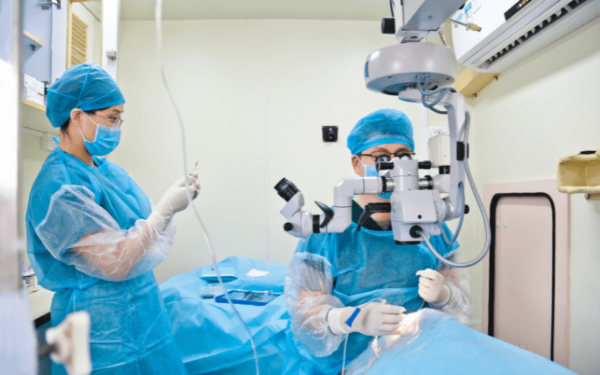 We usually take our human sight for granted. However, some diseases affect our eyesight and it’s important to know about them. A cataract is one such disease. Cataracts will lead to blurred vision and eventually, you may experience blindness. Cataract surgery can rectify the situation. In this article, we will chat briefly about cataracts and 6 key things you should know about cataract surgery.
We usually take our human sight for granted. However, some diseases affect our eyesight and it’s important to know about them. A cataract is one such disease. Cataracts will lead to blurred vision and eventually, you may experience blindness. Cataract surgery can rectify the situation. In this article, we will chat briefly about cataracts and 6 key things you should know about cataract surgery.
Current Perspectives on Cataract
There are 12 million people worldwide that suffer from cataracts. Cataracts mainly occur because of age. As you get older, it’s quite normal that these proteins in the lens of the eye start to break down and clump together. This causes cloudiness in the lens — that is a cataract. By the age of 80, almost everyone has started to develop cataracts.
Cataracts can also appear due to eye injuries and even following eye surgery (e.g. vitrectomy). Other risks include a family history of cataracts, diabetes sufferers, smoking, using corticosteroid medicines for long periods, and spending a lot of time under sunlight. Sometimes cataracts can be present from birth.
Read more: About Cataract
1. What are the Indications of Cataract Surgery?
There are three main types of age-related cataracts: nuclear sclerosis, sub-capsular, and lastly cortical. The indications for cataracts include painless loss of vision, white opacity through the pupil, gradual deterioration of sight, misty or cloudy vision, blurred images, sensitivity to light and glare, and the dimming of colours. Assistive technologies such as optical devices, and electronic magnification can help, but surgery is the most effective treatment for a cataract. The benefits of cataract surgery lead to an improved quality of life and around 80% of patients achieve 6/12 vision or better.
2. How to Prepare for Cataract Surgery?
Normally, once you have been diagnosed with cataracts, ultimately you may need cataract surgery. Cataract Surgery is carried out as day surgery under local anesthetic. The surgery takes around 30 to 45 minutes long. Normally you can go home the same day, but you should organize a ride home with another driver. Besides, you may be instructed not to eat or drink anything 12 hours before cataract surgery. Your doctor may also advise you to stop taking any medication that could increase your risk of bleeding during the procedure. Antibiotic eye drops may be prescribed for use one or two days before the surgery.
On the day of the surgery, you will be given eye drops that include an antibiotic. You will then have a small plastic tube inserted into a vein in your arm. You will also be given an injection around the eye, which will numb your eye. Most patients will have local anaesthetic sedation. Some will have a general anaesthetic. The procedure begins with you being asked to lie on your back for up to 45minutes. The Doctor will make a small cut in the eye to remove the cloudy lens and insert the plastic lens.

3. What to Expect after Cataract Surgery?
It’s normal for vision to feel slightly blurry immediately after surgery and for your eye to be a bit red and sore for the next few days. You will be given a protective plastic shield to tape over the operated eye to protect it. Your vision will continue to improve and stabilize over the following 4-6 weeks of recovery. This avoids foreign particles from entering the eye. Within a few days of the operation, many people often notice their vision is already much better than when they had the cataract.
Problems with cataract surgery are few and far between. A few patients have experienced bleeding, infection, or actual damage to the eye itself. You must alert the medical staff if you notice your eye becoming red and painful or if there is fluid coming from the eye. If your vision progressively is getting worse that is also a tell-tale sign.
Read more: Another Benefit from Cataract Surgery

4. What are the Risks of Cataract Surgery?
For seniors, the risk is higher with cataract surgery. To be specific, cataract surgery may slightly increase the risk of retinal detachment (retinal detachment is a medical emergency). Besides, other eye disorders, such as high myopia (nearsightedness), can further increase the risk of retinal detachment after cataract surgery. One sign of retinal detachment is a sudden increase in flashes or floaters. Floaters can be described as little “cobwebs” type lines or specks that seem to float about in the field of vision. If the elderly parent notices a sudden increase in floaters or flashes, go to an emergency service or hospital, or see an eye care professional immediately — the eye must be examined by an eye surgeon.
Another risk has to do with the eye tissue that encloses the IOL becoming cloudy and may blur vision. This condition is called an after-cataract. An after-cataract can develop months or years after cataract surgery. An after-cataract is treated with a laser. The doctor uses a laser to make a tiny hole in the eye tissue behind the lens to let light pass through.

5. What are the Alternatives to Cataract Surgery?
We note there is a percentage of cataract sufferers that can make use of low-vision aids. Low vision aids and glasses may help you make the most of your remaining eyesight depending on how moderate or severe your cataracts are, your lifestyle, and your regular activities. As an interim solution, an eye specialist may provide low-vision devices that may sharpen your remaining vision.
 Low vision devices include desktop low vision solution like Zoomax’s newly presented Luna HD 24 Pro, which is a transportable read, write and distance video magnifier with 24 LED screens. Put Luna HD 24 Pro in your home, office, or wherever you need to magnify text, view photos, check ingredients on food packaging, do crafts, etc. Another type of low-vision device is the handheld electronic video magnifier, such as Luna 6, and Snow 12 which are easy to use and offer great convenience for low-vision people with cataracts.
Low vision devices include desktop low vision solution like Zoomax’s newly presented Luna HD 24 Pro, which is a transportable read, write and distance video magnifier with 24 LED screens. Put Luna HD 24 Pro in your home, office, or wherever you need to magnify text, view photos, check ingredients on food packaging, do crafts, etc. Another type of low-vision device is the handheld electronic video magnifier, such as Luna 6, and Snow 12 which are easy to use and offer great convenience for low-vision people with cataracts.
 In addition, low-vision E-glasses like Acesight VR, deliver an amazing image even under poor light conditions. And Acesight and Acesight S allow people with cataracts to perform daily activities while making sure to wear them comfortably for long periods.
In addition, low-vision E-glasses like Acesight VR, deliver an amazing image even under poor light conditions. And Acesight and Acesight S allow people with cataracts to perform daily activities while making sure to wear them comfortably for long periods.
6. What Can and Cannot Do after Cataract Surgery?
Your ophthalmologist will provide you with a list of what you can and cannot do after cataract surgery. It’s crucial to follow their advice if you want to recover quickly and completely. Everyone’s recovery time is different and your eye doctor will probably give you instructions based on your case. The things you can do include watching TV, using the computer, taking bath, and reading books, but you should use your eye shield while you sleep, and rest if you feel tired. Besides you need to take your eye drops as directed and wear sunglasses outside.
Let’s now look at some behaviours you should avoid after cataract surgery: first, you should avoid rubbing your eyes and avoid getting shampoo or soap in your eyes. Besides, you need to keep your eyes free of makeup for at least a month and avoid developing eye irritation. After surgery, you need to avoid bending over to reduce pressure and avoid heavy lifting and physical activities and some behaviours like sneezing or throwing up. Swimming and taking aeroplanes are also to be avoided.
On the other hand, with cataracts, prevention is better than treatment. Regular eye examinations can detect cataracts at an early stage. Even if you don’t have any known vision problems, you should visit an optometrist every 2 years. Besides, during your lifetime you can make some good nutritional choices early on. Foods high in antioxidants help the body stay young and stop the aging process. Furthermore, smoking and drinking alcohol is a no-no! These unhealthy elements directly affect your body’s organs in general. You can also avoid ultraviolet light, as ultraviolet light can increase the risk of cataracts.
Conclusion
With today’s advancements in surgical procedures, there is hope for people suffering from Cataracts. Sometimes we are pre-disposed to this illness and so modern cataract surgery is the only option. Of course, modern technology will continue to play a role in the treatment of cataracts.
Reference:
https://www.hopkinsmedicine.org/health/treatment-tests-and-therapies/cataract-surgery
https://www.coastaleyesurgeons.com/blog/what-you-should-and-shouldnt-do-after-your-cataract-surgery
https://armadale-eye.com.au/cataract-surgery-recovery/

